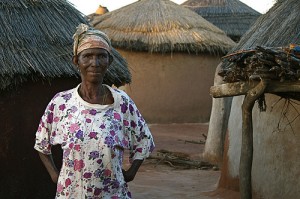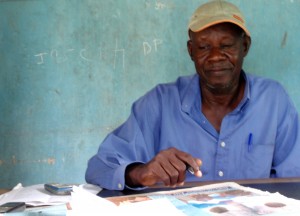The following is the first of six posts I’ll be writing about the witch camps in Northern Ghana. Â Check back every other day for a new post.

An accused witch in Gambaga. (Photo By Brian McAndrew)
I arrive in Gambaga at dusk. The mosques are booming in evening prayer; their exaltations feel eerily clandestine in the murky twilight. The only illumination comes from a single halogen light above a beige sign for Martha’s Memorial Guesthouse. The beam spreads across the soft patch of mud below it like the fingers of an outstretched palm. At its tips sits a rectangle of solid white stone, and in that rectangle rests Martha, forever entombed in a heap of granite her husband purchased to memorialize her.
I arrange a room with Martha’s widower, a bespectacled pastor. There is no running water and there are faded blood stains on the sheets, but at $3.00 a night I don’t expect much. I have come to Gambaga–a small village in Ghana’s Northern Region–to follow up on a story I read in a local newspaper about “witch camps.†From the scant details in the paper, all I know is that Gambaga is one of many refugee camps for women who have been accused of witchcraft and exiled from their villages. The story is provocative enough that I decide to make the eight-hour trip to Gambaga on a whim.
When I awake the next morning, it is to a knock on my door from Simon Ngote, the manger of the witch camp. He had heard from the pastor that an American journalist was in town and assumed I was interested in the witches of Gambaga. Simon is in his late fifties–he has no recorded birth date–and tall and lanky with a grizzled salt and pepper beard. He and his family live in a modest-sized house on the outskirts of the village, which is provided by the Presbyterian Church as part of Simon’s compensation. However, a year ago, the church cut its funding to Gambaga–leaving him in penury. He continues to provide relief to the women in the camp, but has also assumed the role of unofficial tour guide in order to make ends meet.

 Simon Ngote, Manager Gambaga Witch Camp
In his office, a cramped, lightless room adjacent to his home, Simon relays the basic layout and history of Gambaga to me. The camp was founded circa 1900 by an Imam named Baba, who felt pity for the women who were convicted of witchcraft, and at that time, often executed. It currently holds about eighty women; however there are six other camps in the region and their total population numbers over 1,000. According to Ngote, most of the women in the camp were accused of witchcraft in their village and then banished to Gambaga. There, they are overseen by a chief called the Gambarrana, who is supposedly able to subdue them through his spiritual prowess. The women are poverty-stricken and subsist on small earnings they generate from gathering nuts and firewood. I ask Simon if he can help me arrange interviews with some of them. “Sure, should I schedule wizards as well? he asks, dryly.
It is a strange proposition. We agree to meet that evening and I trail off back to the guesthouse, where I watch a gaggle of children play soccer in the grounds surrounding Martha’s tomb. The pastor sits in a plaid lawn chair facing the church. He doesn’t speak to me, but occasionally unveils a toothless smile.
For more images of the Gambaga witch camp, check out the photo gallery.
[…] the first post in this series or check out pictures of Gambaga in the photo […]
[…] the first post in this series or check out the photo gallery for more images from […]